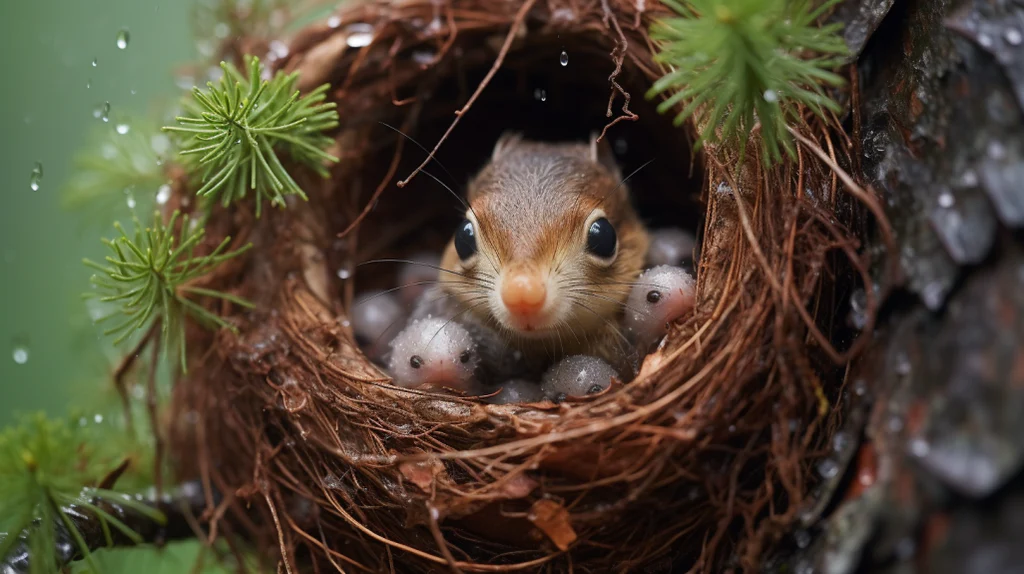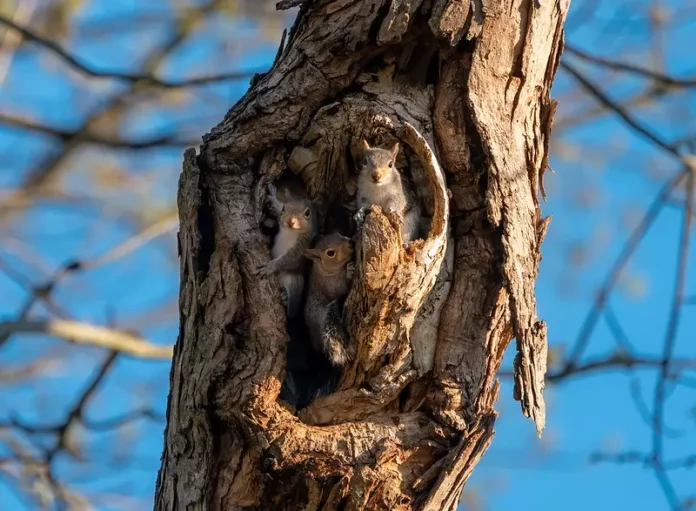As winter approaches and leaves fall from trees, you might notice peculiar spherical structures high up in the branches. These are squirrel nests, also known as dreys, and they represent remarkable examples of animal architecture. Whether you’re a nature enthusiast, property owner, or simply curious about wildlife, understanding these structures can provide fascinating insights into squirrel behavior and habitat preferences.

Table of Contents
Physical Appearance and Structure
At first glance, a squirrel’s nest might appear to be nothing more than a random collection of twigs and leaves. However, these structures are carefully crafted homes that serve multiple purposes throughout the year. The typical squirrel nest measures between one to two feet in width, featuring a distinctive spherical or oval shape that sets it apart from other wildlife dwellings.
From a distance, these nests often resemble “twig footballs” nestled among the branches. The exterior appears somewhat messy and irregular, which actually helps them blend into their surroundings and provide better camouflage against predators. Despite their seemingly chaotic appearance, each nest contains a carefully constructed hollow interior measuring approximately eight inches in diameter – just enough space for a squirrel or a small family to rest comfortably.
One of the most remarkable aspects of these structures is their durability. Despite exposure to wind, rain, and snow, well-constructed dreys can last for several seasons when properly maintained by their industrious builders.
(For more on the best air rifle for squirrels, see this post)

Construction and Materials
Squirrel nests showcase impressive architectural complexity through their three-layer construction system. Each layer serves a specific purpose, contributing to the overall functionality and comfort of the structure:
Outer Layer
The exterior framework consists of carefully woven twigs that form a sturdy, basket-like foundation. This layer provides the basic structure and support for the entire nest. Squirrels select twigs of various sizes, interweaving them to create a robust outer shell that can withstand severe weather conditions.
Middle Layer
Between the outer framework and inner chamber, squirrels pack a dense layer of insulating materials. This middle section typically includes:
- Compressed leaves
- Moss
- Bark strips
- Found materials (sometimes including paper or cardboard in urban areas)
This layer serves as crucial insulation and helps reinforce the overall structure, making it more weather-resistant and comfortable for its inhabitants.
Inner Chamber
The innermost section of the nest is where squirrels spend their time resting and raising young. This chamber is lined with the softest materials they can find:
- Fine moss
- Soft grasses
- Pine needles
- Feathers
- Fur (often collected from naturally shed animal fur)
Unlike bird nests, which typically feature a bowl-shaped depression for eggs, squirrel nests maintain a more enclosed, cave-like interior space. This design helps maintain warmth and provides better protection from the elements.

Location and Positioning
The placement of a squirrel nest is far from random. These clever creatures carefully select locations that optimize safety, accessibility, and protection from the elements. Most dreys are constructed at least 20 feet (6 meters) above ground level, placing them well out of reach of many ground-based predators.
Preferred Trees
Squirrels show clear preferences for certain tree species when building their nests:
- Oak trees (excellent for both nest-building and food sources)
- Beech trees
- Elm trees
- Maple trees
- Conifers (especially valuable for year-round cover)
Strategic Positioning
Within their chosen tree, squirrels typically position their nests in one of two optimal locations:
- Near the main trunk, where sturdy branches intersect
- In the secure fork of two strong branches
The nest entrance is invariably oriented toward the tree trunk, providing additional protection from weather and predators while offering a quick escape route if needed.
Seasonal Variations
One of the most interesting aspects of squirrel nests is how they adapt to different seasons. Squirrels actually maintain different types of nests throughout the year, modifying their construction based on seasonal needs.
Summer Nests
Summer dreys are characterized by:
- Lighter construction
- More open and airy design
- Flatter overall structure
- Less insulation material
- Better ventilation
These modifications help prevent overheating during warmer months while still providing adequate protection from summer storms and predators.
Winter Nests
Winter dreys feature significant modifications:
- Bulkier construction
- Thicker walls
- More insulation material
- More compact design
- Better weatherproofing
During colder months, squirrels may also share nests to conserve body heat, making these winter structures particularly important for survival.
Managing Squirrel Nests in Human Spaces
While squirrel nests in natural settings rarely cause problems, they can become concerning when built in or around human structures. Here’s how to address squirrel nests responsibly when they appear in unwanted locations:
Prevention
The best approach is to prevent squirrels from building nests in the first place:
- Seal potential entry points around your home
- Trim tree branches that provide easy access to your roof
- Install appropriate chimney caps
- Maintain regular property inspections
Professional Removal
If you discover a squirrel nest in your attic or other part of your structure:
- Never attempt to remove an active nest yourself
- Contact licensed wildlife professionals
- Ensure humane removal methods are used
- Address entry points to prevent future occurrences
After Removal
Once the nest is professionally removed:
- Inspect for and repair any damage
- Clean and disinfect the area
- Install preventive measures
- Monitor for signs of return












































